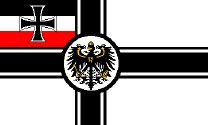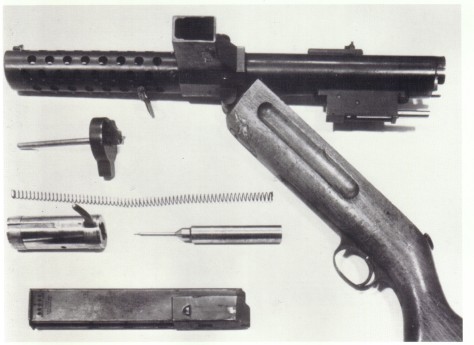CRUFFLER.COM
presents
HISTORIC
FIREARM OF THE MONTH,
July
2000:
 |
 |
 |

Image Credit: Gotz, Hans Dieter, German Military Rifles and Machine Pistols, 1871-1945, Schiffer Publishing, Ltd., (West Chester, Pennsylvania: 1990) Page 223 |
Type:
Submachinegun (Machine Pistol)
System of Operation: Blowback Caliber: 9mm Parabellum Capacity: 20 rounds (32 with snail drum magazine) Sights front: Blade Sights, rear: Two position flip v-notch rear (100/200m) Length: 52" Weight (unloaded): 11.5 lbs Barrel: 22.8" |
In 1915 the German Rifle Testing Commission at Spandau identified a set of requirements for a new weapon for use in the specialized conditions of the trenches. It was to be an individual weapon, light in weight, and capable of fully automatic fire. The weapon was to be optimized for close combat at ranges of no more than 200 meters, as simple in construction as possible, and to be chambered for the 9mm Parabellum cartridge. Originally, the Commission had planned to convert the Artillery Luger, with its eight inch barrel and shoulder stock to a fully automatic configuration, but this proved to be impractical. The pistol's cyclic rate was much too high, and its light weight made it difficult, if not impossible to keep it on target in the fully automatic mode. Based on this turn of events, the Commission determined that a completely new kind of weapon was needed. Two designers, Andreas Schwarzlose in Berlin, and Hugo Schmeisser in Suhl, turned their talents to the weapon's development. Schmeisser's gun, under the sponsorship of Waffenfabrik Theodor Bergmann, was selected by the Commission in 1918. The weapon was designated Maschinenpistole (MP) 18, I. There never was an MP18, and there is no clear cut explanation as to why the I was appended to the nomenclature.
In 1918, the Prussian War Ministry ordered 50,000 MP18,I's, from Waffenfabrik Theodor Bergmann. Plans were laid to incorporate six machine pistol detachments per infantry company. Each detachment was to consist a shooter and an ammunition carrier. Each detachment was to have a basic load of 2,500 cartridges, some of which would be carried in magazines and the rest in collapsible boxes. As it often turns out with the best laid plans of mice and, it did not come to fruition. By Armistice Day, November 11, 1918, fewer than 10,000 MP18,I's had made it to the front. Nevertheless, their impact had been significant. The victorious allies, mindful of what the MP18, I's had wrought in the trenches, banned Germany's continued development and production of machine pistols. Despite this, Waffenfabrik Bergmann continued to produce the MP18,I until 1920.
After
Waffenfabrik Bergmann ceased production of the MP18,I, it came to a licensing
agreement with the Swiss Industrial Company (SIG), which was based in Neuhausen,
Switzerland. The MP18, I continued to be produced in numbers by SIG
into the 1920's for foreign sales, most notably to Japan. Despite
the strictures of the Treaty of Versailles, the adoption of Schmeisser's
"maschinenpistole," or machine pistol, put Germany squarely at the head
of weapons technology among the belligerent nations, and it retained this
position until the Second World War.
A
CLOSER LOOK
The
MP18,I ushered in a new era in weapon simplification. There were,
counting the magazine but not the screws, only 34 individual parts.
As with most military weapons of the era, it is excellently manufactured
from machined forgings, and displays an almost commercial level of fit
and finish. The walnut half stock is of the same shape as that of
Gewehr 98 rifle and carries the rear half of the receiver tube. The
front half of the receiver tube is perforated and acts as both a barrel
cooling jacket and handguard. At the rear of the barrel jacket (midway
along the receiver tube), there is a magazine well which allows the magazine
to be inserted from the left. Opposite the magazine well is a cut
out which serves as the ejection port.
The bolt, which weighs about 22 ounces (700 grams), reciprocates in the rear section of the receiver, behind the 7.8 inch barrel which is surrounded by the cooling jacket. The bolt has a spring loaded extractor and a curved cocking handle that extends through a slot in the right side of the receiver. The cocking handle reciprocates during firing. There is a notch at the top of the rear end of the cocking handle slot into which the cocking handle can be turned in order to secure the bolt.
| The
recoil spring rides inside the hollow firing pin extension at the forward
end and an extension from the receiver cap at the rear. The firing
pin extension fits inside the bolt and thus transmits the forward impulse
of the recoil spring to the bolt. The ejector is rigidly mounted
on the left interior wall of the receiver, and the bolt is relieved with
a slot so that it can clear the extractor during firing.
The trigger housing is secured inside the |

Image Credit: Gotz, Hans Dieter, German Military Rifles and Machine Pistols, 1871-1945, Schiffer Publishing, Ltd., (West Chester, Pennsylvania: 1990) Page 225 |
OPERATION
The
MP18, I fires from an open bolt, which means that prior to firing, the
bolt is held to the rear by the trigger sear against pressure from
the recoil spring. When the trigger is pressed, the sear frees the
bolt to go forward under the recoil spring pressure. The firing pin
point is projecting from the front of the breech face. As the bolt
moves forward, it strips the topmost cartridge from the magazine, pushes
it into the chamber, and comes to a stop against the rear face of the chamber.
At this instant, the firing pin detonates the primer, and fires the cartridge.
As the propellant gasses expand, they operate on both the bullet, forcing it down the barrel, and the bolt, forcing it to the rear against the recoil spring. Since the breech is about a hundred times more massive than the bullet, it moves much more slowly. In fact, by the time the bullet has left the barrel, the breech has not moved to rear far enough to fully withdraw the fired case from the chamber. The bolt continues to the rear, extracting the spent cartridge, and ejecting it to the left, out the ejection port, and then continues to the rearward limit of travel. At this point, and until the trigger is released, the bolt moves forward under spring pressure, repeating the cycle. There is no provision for semiautomatic fire.
MAGAZINES
As originally
fielded, the MP18, I was equipped with the "snail drum" 32 round magazine
from the Artillery Luger pistol, which was inserted into an special magazine
well which was angled some sixty degrees to the rear so as to ensure that
the rounds were presented to the bolt at the optimum feed angle.
Postwar production MP18, I's used a Schmeisser designed 20 round staggered
row stick magazine and were equipped with a different magazine well which
was not angled and had a wider mouth. The twenty round magazines
were produced by the C.G. Haenel firm of Suhl. Interestingly, Hugo
Schmeisser had originally designed the MP18, I to accept a staggered row
stick magazine, and had only changed the design to accept the snail drum
magazine at the request of the Rifle Testing Commission.
EPILOGUE
The
MP18, I represented a new era in both technology and tactics. It
was the height of weapons technology when it was introduced.
In basic mechanism it was to remain so for almost 70 years. An even
more interesting testament was that the German Army, which had pioneered
the tactical employment of the submachinegun, did not issue a new model
of submachinegun to its forces until 1938 when the MP38 was introduced.
Just as the Model 1886 Lebel rifle deserves a place in the Cruffler Pantheon
for being the first small bore smokeless powder repeating rifle, the MP18,
I deserves a place for ushering in a new era in tactics and firepower.
BIBLIOGRAPHY
Gotz, Hans Dieter, German Military Rifles and Machine Pistols, 1871-1945, (Schiffer Publishing, Ltd. West Chester, Pennsylvania, 1990)
Smith, W.H.B, A Basic Manual of Military Small Arms, (Military Service Publishing Company, Harrisburg, Pennsylvania, 1945)
German
Military Rifles and Machine Pistols, 1871 - 1945 is available from
Amazon.com. Click on the image to order:

A
Basic Manual of Military Small Arms is an old and out of print volume.
Check with your internet or local rare/used bookseller to inquire about
obtaining a copy.